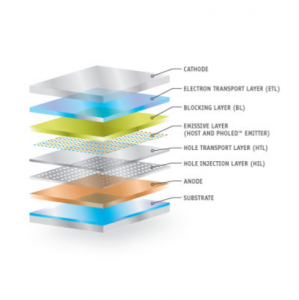NEW FOCUS OF LED INCLUDES THE POLYMER-OLED OR OLED
An LED or light emitting diode display is a resource well known in the vernacular of cost effective purposing of contemporary lighting. Progress with the technological components of LED’s has elevated its stature in the debate of contemporary surface displays for motion content. Currently there are two forms of LEDs, discrete LEDs and surface mounted device panels.
Surface mount device panels represent a paradigm similar to the LCD panel where there is a thin layer of silicon backing in the rear of the component. Surface mounted LEDs currently provide better reliability for picture and video content amongst LEDs.
Discrete are the more desirable variation of Light Emitting Diodes for investors peering into the future. Discrete LEDs are capable of illuminating individually without dependency to arrays of LEDs or a surface mounting. This autonomous nature of the LED opens the avenue for raising and advancing the flexibility of surface display devices.
The most common variants of progressive LED technologies are the field-emission related technology or SED LED (surface-conduction electron-emitter display) and polymer related OLEDs (Organic Light Emitting Diodes). While the Field-Emission SED is intriguing based on display capabilities similar to a CRT television, they have lost significant confidence from the LED investment community.
The majority of attention in the LED community is dedicated to Organic Light Emitting Diodes “regarded by many as the next generation of lighting and display technology, but it is the display market which tends to get more publicity. OLEDs are capable of high resolution pixel patterning, producing high contrast displays of good color gamut, extremely wide viewing angle and low power consumption. Their rapid response – atleast a thousand times faster than liquid crystal displays (LCDs) – is a major factor in their likely replacement of LCDs in applications such as television and cell phones.”[13]
“Organic and polymer light emitting diodes (LEDs) have been investigated for a number of years for possible use in backlighting and display applications. Recent advances in both small molecule and polymer based LED technology have led to dramatic increases in device lifetime, which have paved the way for their commercialization. Attention has also been paid to addressing issues of high information content display based on such LEDs.”[16]
OLED technology is advantageous based on the aspect that there is no backlight needed for the image to function and “simple printing process”.[16] The lack of backlight creates avenues where the product may be flexible, transparent, and mold to desired parameters.

While long developed as a protypical display surface, the OLED has been utilized in cell phones, PDAs and digital cameras since 2004 from Kodak and Sony. In October 2007, Sony launched the XEL-1, an 11-inch OLED Digital TV with an contrast ratio of 100,000,000:1. Amazon lists this product at a price of $2,500 with a 36” expected in 2011.[26]

